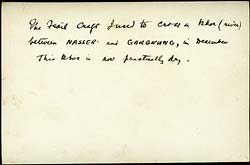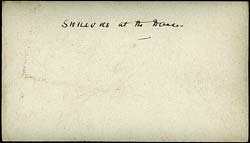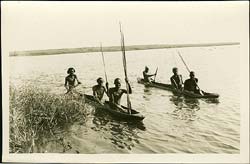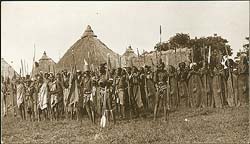Photographer
- John E. Allen
- Richard Buchta
- Jean Carlile Buxton
- E. E. Evans-Pritchard Collection:
- Godfrey Lienhardt
- Charles Kingsley Meek
- G. N. Morhig postcard series:
- Percy Horace Gordon Powell-Cotton
- Charles Gabriel Seligman slide collection
- Wilfred Patrick Thesiger
Charles Kingsley Meek ( 1885-1965)
View photographs by Charles Kingsley Meek.
Having studied Theology at Oxford, Meek joined the colonial service and was posted to northern Nigeria in 1912. This was the period when the governor-general Frederick Lugard was about to embark on extending his policy of indirect rule from a successful north to the south of the country, and fundamental to such a policy was a systematic understanding of traditional institutions. On being appointed to one of the two posts of Government Anthropologist, Meek's work ethnological studies led to his 1925 publication, The Northern Tries of Nigeria , which was followed in 1931 by A Sudanese Kingdom , a study of 'divine kingship' among the Jukun-speaking peoples. Promoted to the rank of Resident and transferred to the southern provinces of Nigeria in 1929, Meek resigned from the colonial service because of ill health in 1933.
Meek devoted the second half of his life to the scholarly study of the field in which he had acquired such an extensive experience in his first career, benefiting from the help of such anthropologists as R. R. Marett and C. G. Seligman. In recognition of this and his established record of research, he was granted leave by Oxford University in 1934 to supplicate for the degree of DSc. Two years later the Royal Anthropological Institute (he was a fellow both of that institute and of the Royal Geographical Society) awarded him its Wellcome Medal.
It is uncertain when and why Meek undertook an expedition to Southern Sudan. The photographs themselves suggest hunting to have been a major reason, and the locations seem to be confined to the banks of the Sobat River in Upper Nile, as far as some of the Anuak communities to the southeast near the confluence with the Pibor.
Scope of the collection: 74 film negatives and 34 prints.
 Reverse of 1998.204.11.1 inscribed "The frail craft I used to cross a khor (river) between Nasser and Gargwang, in December. This khor is now practically dry."
Reverse of 1998.204.11.1 inscribed "The frail craft I used to cross a khor (river) between Nasser and Gargwang, in December. This khor is now practically dry."
This ink manuscript note on a print reverse is the only locational documentation that we have for Meek's southern Sudan photographs, although he donated numerous others relating to Nigeria in 1930. It is possible that he donated his southern Sudan photos at around the same time at those relating to Nigeria, but they were certainly not integrated into the Museum's photograph collection in the same way, which was to be pasted onto large boards for contextual research.
 Reverse of 1998.204.11.8 inscribed "Shilluks at the dance"
Reverse of 1998.204.11.8 inscribed "Shilluks at the dance"
This brief manuscript note suggests that Meek visited some locations in Upper Nile during his expedition, visiting a Shilluk gathering, seemingly organised or at least officiated by colonial administrators, one of whom can be seen standing in front of the group. This series of Shilluk prints are quite distinct from those made up from the Nuer and Anuak negatives, being smaller and with a purple tone common to some printing-out papers of the period.



